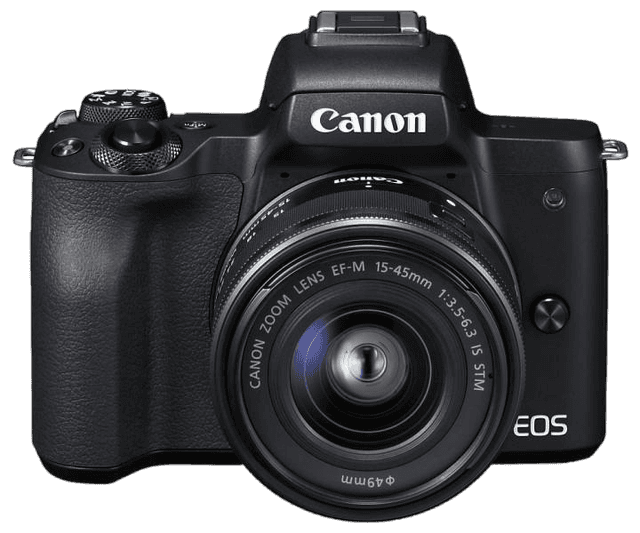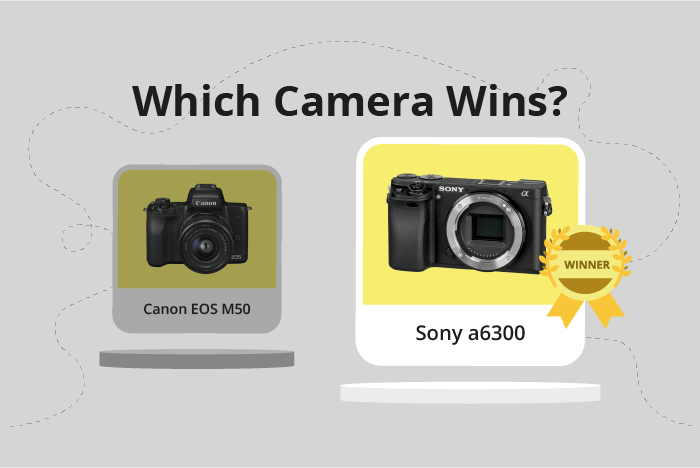Canon EOS M50 vs Sony a6300 Comparison
Canon EOS M50

Sony a6300

The Sony a6300 takes the lead with a score of 61/100, while the Canon EOS M50 trails close behind at 59/100. Both cameras are mirrorless and were released within two years of each other, with the Sony a6300 launching in 2016 and the Canon EOS M50 in 2018. They share similarities in size and weight, as the Sony a6300 measures 120 x 67 x 49mm and weighs 404g, while the Canon EOS M50 comes in at 116 x 88 x 59mm and 390g.
Though the Sony a6300 has a higher score, the Canon EOS M50 holds its own with a lower launch price of $779 compared to the Sony a6300’s $1000. However, the Sony a6300’s better score highlights its superior performance and features, making it worth the higher price for some users.
Despite the slight difference in scores, both cameras offer quality performance and share key specifications. Choosing between the two ultimately depends on individual preferences and budget constraints.
Canon EOS M50 vs Sony a6300 Overview and Optics
The Sony a6300 outperforms the Canon EOS M50 in optics with a score of 68/100, compared to the M50’s 59/100. Both cameras share several specifications, including 24 megapixels (24.2 for the a6300), CMOS sensors, APS-C sensor size, and the absence of image stabilization. Moreover, they have similar shooting speeds with the M50 at 10 frames per second and the a6300 at 11 frames per second.
The Sony a6300 excels with its higher DXOMARK sensor score of 85, compared to the Canon EOS M50’s 58. This difference results in better image quality and low-light performance. Additionally, the a6300’s Bionz X processor provides faster image processing, contributing to its slightly higher shooting speed.
Although the Canon EOS M50 falls behind the a6300 in terms of optics, it still has some advantages. The M50 features the Digic 8 processor, which is known for its reliable performance. Furthermore, the Canon EF-M lens mount offers compatibility with a wide range of Canon lenses, providing versatility for photographers.
Taking these factors into account, the Sony a6300 is the superior choice for those prioritizing optics and image quality. Its higher DXOMARK sensor score and faster processor ensure better results in various shooting conditions. On the other hand, the Canon EOS M50 is a viable option for photographers who value lens compatibility and the reliable performance of the Digic 8 processor.
Canon EOS M50 vs Sony a6300 Video Performance
The Canon EOS M50 and the Sony a6300 both achieve a video score of 91/100, indicating that they have comparable video capabilities. Both cameras share key specifications, such as 4K max video resolution, max video dimensions of 3840 x 2160, a max video frame rate of 120fps, and built-in time-lapse functionality.
The Canon EOS M50 stands out with its user-friendly interface and compact design, making it a popular choice for beginners and enthusiasts alike. The camera’s Dual Pixel autofocus system ensures fast and accurate focusing during video recording, providing a smooth and professional result. Additionally, the EOS M50 offers a fully articulating touchscreen, allowing for easy control and monitoring during video capture.
On the other hand, the Sony a6300 boasts a more robust build and a higher dynamic range, which can result in better video quality in challenging lighting conditions. Furthermore, the a6300 features advanced video profiles such as S-Log, which provides greater flexibility in post-production color grading. This camera also benefits from a larger selection of native lenses, giving users more options to achieve their desired look.
Both cameras offer impressive video capabilities, with the Canon EOS M50 excelling in ease of use and autofocus performance, while the Sony a6300 shines with its advanced video profiles and greater lens selection. Ultimately, the choice between these two cameras will depend on the user’s priorities and preferences.
Canon EOS M50 vs Sony a6300 Features and Benefits
The Canon EOS M50 emerges as the winner with a feature score of 70/100, while the Sony a6300 scores 54/100. Both cameras share several features, including a 3-inch screen size, flip screen, and the absence of GPS. Additionally, both cameras are equipped with WiFi capabilities.
The Canon EOS M50 outperforms the Sony a6300 in several aspects. Firstly, the M50 has a higher screen resolution of 1,040,000 dots, compared to the a6300’s 921,600 dots. This results in a clearer and sharper display for the user. Secondly, the M50 has a touchscreen, which makes it more user-friendly and convenient to navigate through settings and menus. Lastly, the M50 also has Bluetooth connectivity, allowing for seamless integration with other devices and simpler image transfer.
On the other hand, the Sony a6300 has a few advantages over the Canon EOS M50. It shares the same screen size and flip screen capabilities, making it equally versatile for various shooting angles. However, the absence of touchscreen and Bluetooth connectivity makes it slightly less user-friendly and convenient compared to the M50.
Taking into account the various features and specifications, the Canon EOS M50 proves to be the better camera due to its higher screen resolution, touchscreen, and Bluetooth connectivity. These features make it more user-friendly and versatile than the Sony a6300. Although the a6300 has some advantages, they are not significant enough to surpass the M50’s overall performance and functionality.
Canon EOS M50 vs Sony a6300 Storage and Battery
The Sony a6300 outperforms the Canon EOS M50 in storage and battery, scoring 24 points compared to the M50’s 13 points. Both cameras share similarities in this aspect, as they each possess one memory card slot and accept SD, SDHC, and SDXC memory cards. Neither camera offers USB charging capabilities.
The a6300’s superior battery life sets it apart from the M50, providing 400 shots compared to the M50’s 235 shots. The a6300 uses the NP-FW50 battery type, while the M50 uses the LP-E12 battery type. However, the M50 has the advantage of being compatible with UHS-I memory cards, offering faster read and write speeds for improved performance.
In terms of storage and battery, the Sony a6300 holds a clear advantage due to its longer battery life, while the Canon EOS M50’s UHS-I compatibility offers a slight edge in memory card performance.
Canon EOS M50 vs Sony a6300 – Our Verdict
Are you still undecided about which camera is right for you? Have a look at these popular comparisons that feature the Canon EOS M50 or the Sony a6300:

